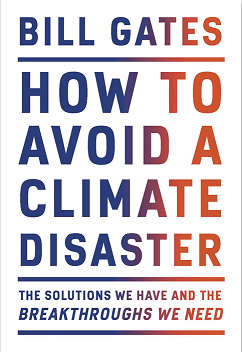Bill Gates’ vision of the climate crisis is not a positive one: changing our behavior is not nearly enough to get our emissions down to zero by 2050. Planting trees will not save us either. And investing a lot of money in products with lower emissions to meet our climate targets in 2030 is not a good idea. However, we must start doing something super quickly now! But what? Gates’ book How to avoid a climate disaster from early 2021 gives us the answer: technology!
The main message of the book is that we need green (completely emission-free) technological solutions. Some solutions already exist, and others still need to be discovered. A question of supply and demand. Because we need to deploy those solutions! The problem with the demand side is that “green” solutions are still more expensive than “non-green” ones. We need to change that. We can do this by making green solutions cheaper, for example by scaling them up. This can also be done by making non-green solutions more expensive. There are already many solutions with a relatively low additional green price. We can, no, we must use them now. And if we are not already doing so, why not?
The climate problem
The book starts with three general chapters. Why is it necessary to go to zero emissions, how difficult is that and how do you keep focus on the big picture? That it is necessary seems obvious, but Gates briefly explains the difference between 1.5 and 2 degrees warming. It’s not just 0.5 degrees, but a doubling of misery in terms of lack of clean water, reduced corn harvests, warmer and more humid air, mosquitoes (bringing malaria) moving to more humid areas, heat strokes because we do not sweat properly in humid air … and much more. Not new, but good to set the stage.
CO2 emissions, from where and how much?
Then Gates zooms in on technological areas where there is much to be gained: energy supply (which accounts for 27% of our emissions), industry and construction (31%), food supply (19%,) transport (16%) and heating/cooling (7%).
In these chapters I found a lot of information that was new to me. Such as the differences in capacity versus the space occupied by various energy sources. Gates seems to be a fan of nuclear power: nuclear fission and nuclear fusion. Emission-free, reliable, takes up little space and can be used on a large scale. But also initially expensive, by building nuclear power plants, and unsafe: uranium can be abused, and waste is difficult to store. We must therefore work on a solution; this could be a travelling wave reactor. Nuclear fusion is even more promising, if possible, because it runs on … seawater.
An eye-opener for me in the industry/construction chapter was the observation of the enormous emissions from cement and steel. We are going to use more and more of these materials, because of the growing world population, but also because everyone rather lives in a concrete house than in a thatched cabin. Concrete and steel cannot be made without releasing CO2, because that is a by-product of the production process. Limestone plus heat equals calcium plus CO2. Iron ore plus coal equals steel plus CO2. The solution would have to be carbon capture, which is expensive …
Of course, there is a tasty explanation of defecating, burping and farting cows, our appetite for meat, artificial fertilizers for plants and the replacement of farmland with forests. About the latter: it has been calculated that half of the earth needs to be forested to absorb the emissions of Americans alone.
What should we do?
This part is followed by a few chapters with concrete points of attention for climate action; adapting to a warmer world, government policy, a holistic plan towards zero, and what we can do individually. Interesting is Gates’ warning that if we focus too much on reducing emissions in 2030, we may make it very difficult to reach zero emissions in 2050. As an example, Gates mentions gas plants: lower emissions as compared to coal, but those gas plants will still be in operation in 2050 to make them profitable, and they will still be emitting greenhouse gasses.
The Third World
Gates would not be Gates if he did not regularly raise the issue of the poorest of the poor. Can you forbid a poor farmer to buy a second cow, so that he can save some more money and send his child to school? After all, a second cow doubles his CO2 emissions. Shame on him! Also, the very poorest will be the first to suffer from the consequences of climate catastrophe, such as extreme droughts and floods.
Gates and sustainability?
Many books on sustainability are being published right now. And to many people, Gates’ knowledge will not be new. So why read this book? I think the advantage of Gates is that he has a lot of power, both through his reputation and through the Gates Foundation, and that he can therefore exert above-average influence on government leaders, CEOs etc. This means that his opinion is important. In addition, he has “skin in the game”, in the sense that he finances/financed several start-ups (frequently one goes bankrupt) that focus on sustainability. He has already put more than a billion dollars into emission-free technology. He walks the talk. A good reason for him to delve into it extensively and pick the brains of many scientists.
These scientists focus on the “hard side”, i.e. technology. Gates is of course a “technophile”, as he admits in his foreword. In the book, he talks little about changing behavior. Less flying and driving helps, but not enough, as we saw in 2020, during the Corona crisis. Emissions were reduced by only 5%. To stop eating meat is difficult (especially for Americans) but Gates has high hopes for meat substitutes and especially for cultured meat. However, he concludes that behavioral change will never be enough to bring our emissions to zero, hence his focus on technology.
Evaluation
Apart from the interesting content, this book is also very well written. Gates makes it personal with his own experiences, especially those in the third world. In addition, it seems scientifically well-founded, while he explains all the technology in a simple way, with figures and calculations. You cannot help but come to the same conclusion.
And now what? What can you do as an individual? Gates: Vote of course, for a climate-friendly party (you probably have), choose emission-free products as a consumer, invest in emission-free innovations as a company. And above all: talk to the people around you, in a positive way, with an opinion based on facts. In other words, choosing and influencing. Ah, there it is: our behavior!
Gates, B. (2021). How to Avoid a Climate Disaster: The Solutions We Have and the Breakthroughs We Need. Knopf. ISBN 978-0385546133




